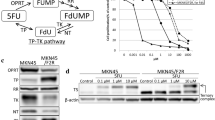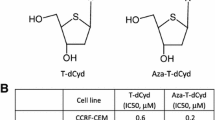Abstract
(E )-2′-Deoxy-2′-(fluoromethylene)cytidine, MDL 101,731, has shown potent antitumor activity against various human xenograft models. Purpose: The purpose of this study was to elucidate the mechanism of the antitumor activity of MDL 101,731 against human carcinoma cells through investigating metabolism and the target enzyme of MDL 101,731. Methods: In respect of the intracellular metabolism of MDL 101,731, the effect on enzymes in the pyrimidine salvage pathway and the intracellular metabolites of MDL 101,731 were investigated. In respect of the target enzyme, the effect on intracellular deoxyribonucleoside triphosphate (dNTP) pools and the inhibition of the enzyme activity were investigated. Results: MDL 101,731 which shows antiproliferative activity against human cervical carcinoma HeLa S3 cells at nanomolar concentrations (IC50, 30–50 nM ), was hardly metabolized to (E)-2′-deoxy-2′-(fluoromethylene)uridine (FMdU) which had no antiproliferative activity below 100 μM because of resistance to human cytidine deaminase. MDL 101,731 showed low activity against murine lymphocytic leukemia P388R cells (Ara-C-resistant cells) which contained lower deoxycytidine kinase activity than parental P388 cells. In addition, the antiproliferative activity of MDL 101,731 against HeLa S3 cells was reversed by deoxycytidine. Studies of the intracellular metabolism of 3H-MDL 101,731 demonstrated that it was rapidly metabolized to the diphosphate and the triphosphate forms without the other metabolites in HeLa S3 cells. A 3-h treatment with 0.1–10 μM MDL 101,731 decreased intracellular dNTP pools. The recovery of dNTP pools decreased by treatment with 2 μM MDL 101,731 was much slower than the recovery following treatment with 10 mM hydroxyurea, a reversible ribonucleotide reductase inhibitor. At a dose of 250 mg/kg, MDL 101,731 continuously inhibited ribonucleotide reductase activity up to 72 h in a HeLa S3 xenograft model. Conclusions: This study suggests that the prolonged ribonucleotide reductase inhibition by rapidly activated metabolites of MDL 101,731 in part contributes to the potent antitumor activity of this drug against various xenografts.
Similar content being viewed by others
Author information
Authors and Affiliations
Additional information
Received: 18 March 1997 / Accepted: 14 July 1997
Rights and permissions
About this article
Cite this article
Takahashi, T., Nakashima, A., Kanazawa, J. et al. Metabolism and ribonucleotide reductase inhibition of (E )-2′-deoxy-2′-(fluoromethylene)cytidine, MDL 101,731, in human cervical carcinoma HeLa S3 cells. Cancer Chemother Pharmacol 41, 268–274 (1998). https://doi.org/10.1007/s002800050739
Issue Date:
DOI: https://doi.org/10.1007/s002800050739




